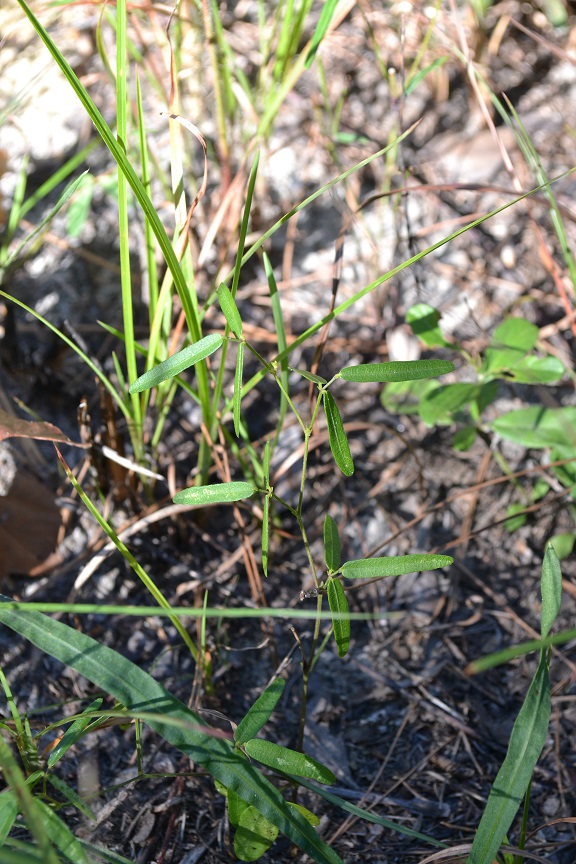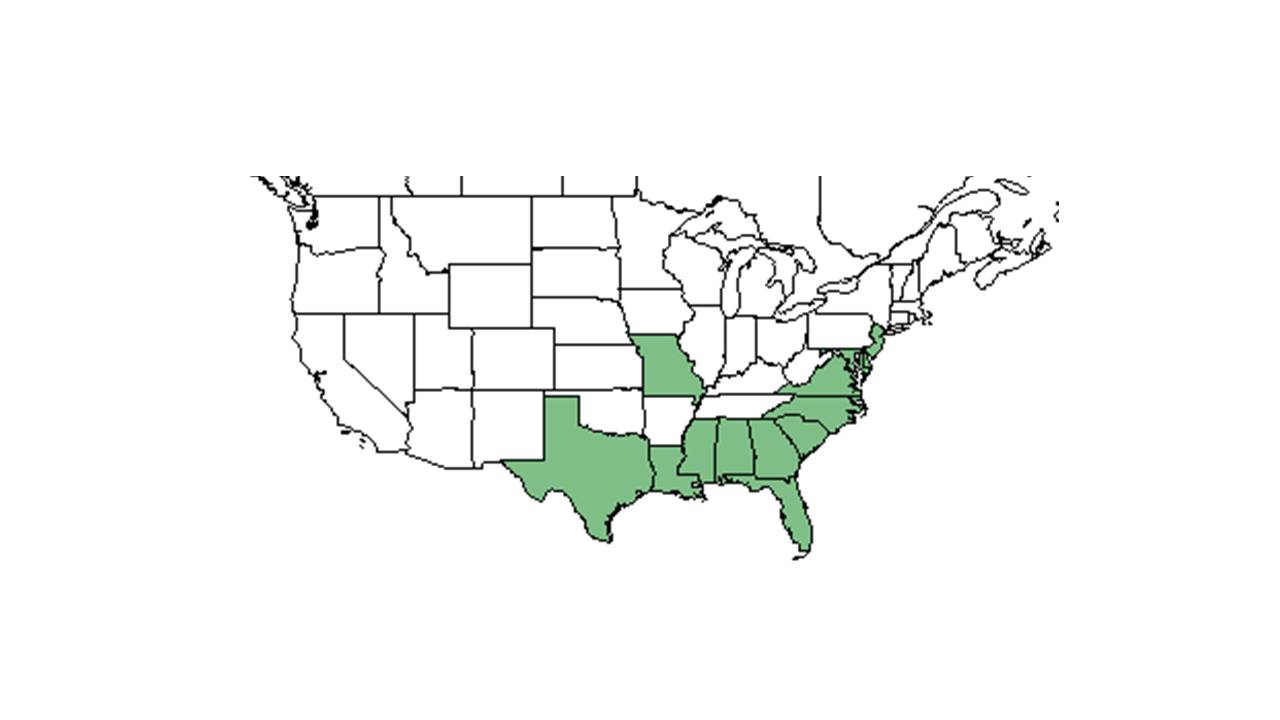Difference between revisions of "Desmodium strictum"
Lsandstrum (talk | contribs) |
Lsandstrum (talk | contribs) |
||
| Line 32: | Line 32: | ||
==Ecology== | ==Ecology== | ||
===Habitat=== <!--Natural communities, human disturbed habitats, topography, hydrology, soils, light, fire regime requirements for removal of competition, etc.--> | ===Habitat=== <!--Natural communities, human disturbed habitats, topography, hydrology, soils, light, fire regime requirements for removal of competition, etc.--> | ||
| − | Generally, ''D. strictum'' can be found in dry woodlands and sandhills.<ref name= "Weakley"/> It thrives in open, frequently burned areas such as longleaf pine and shortleaf pine old field habitats (ultisols). <ref name=cof> Coffey, K. L. and L. K. Kirkman (2006). "Seed germination strategies of species with restoration potential in a fire-maintained pine savanna." Natural Areas Journal 26: 289-299. </ref> <ref name=fsu> Florida State University Robert K. Godfrey Herbarium database. URL: http://herbarium.bio.fsu.edu. Last accessed: June 2014. Collectors: L. C. Anderson, R. K. Godfrey, V. Sullivan, J. Wooten, R. Kral, James R. Ray Jr., John Morrill, Robert L. Lazor, Andre F. Clewell, and T. MacClendon. States and Counties: Florida: Bay, Bradford, Franklin, Gadsden, Hernando, Jackson, Leon, Putnam, Taylor, Wakulla, and Walton. Georgia: Baker, Grady, and Thomas.</ref> It also occurs in longleaf pine-turkey oak sandhills (entisols), and in longleaf pine and slash pine flatwoods (spodosols).<ref name=fsu/> It occurs in habitats dominated by ultisol soil types with average temperatures from 11 to 27° Celsuis, and with 132 cm of annual rainfall. <ref name=cof/> In florida, ''D. strictum'' is an indicator species of the clayhill longleaf woodlands community.<ref>Carr, S. C., et al. (2010). "A Vegetation Classification of Fire-Dependent Pinelands of Florida." Castanea 75(2): 153-189.</ref> It is seen in habitats with soil types of sandy loam to eroded sandy clayey areas. <ref name=fsu/> It prefers to grow in either partial shade or full shade.<ref>[[https://www.wildflower.org/plants/search.php?search_field=&newsearch=true]] Lady Bird Johnson Wildflower Center. Accessed: April 26, 2019</ref> Outside of the southeast coastal plain, ''D. strictum'' can be found in upland pitch pine barrens in New Jersey.<ref>[[http://explorer.natureserve.org/]] NatureServe Explorer. Accessed: April 26, 2019</ref> ''D. strictum'' responds positively to soil disturbance as observed from old field longleaf communities in South Carolina.<ref>Brudvig, L.A. and E.I. Damchen. (2011). Land-use history, historical connectivity, and land management interact to determine longleaf pine woodland understory richness and composition. Ecography 34: 257-266.</ref> It also responds positively to soil disturbance by agriculture, indicating | + | Generally, ''D. strictum'' can be found in dry woodlands and sandhills.<ref name= "Weakley"/> It thrives in open, frequently burned areas such as longleaf pine and shortleaf pine old field habitats (ultisols). <ref name=cof> Coffey, K. L. and L. K. Kirkman (2006). "Seed germination strategies of species with restoration potential in a fire-maintained pine savanna." Natural Areas Journal 26: 289-299. </ref> <ref name=fsu> Florida State University Robert K. Godfrey Herbarium database. URL: http://herbarium.bio.fsu.edu. Last accessed: June 2014. Collectors: L. C. Anderson, R. K. Godfrey, V. Sullivan, J. Wooten, R. Kral, James R. Ray Jr., John Morrill, Robert L. Lazor, Andre F. Clewell, and T. MacClendon. States and Counties: Florida: Bay, Bradford, Franklin, Gadsden, Hernando, Jackson, Leon, Putnam, Taylor, Wakulla, and Walton. Georgia: Baker, Grady, and Thomas.</ref> It also occurs in longleaf pine-turkey oak sandhills (entisols), and in longleaf pine and slash pine flatwoods (spodosols).<ref name=fsu/> It occurs in habitats dominated by ultisol soil types with average temperatures from 11 to 27° Celsuis, and with 132 cm of annual rainfall. <ref name=cof/> In florida, ''D. strictum'' is an indicator species of the clayhill longleaf woodlands community.<ref>Carr, S. C., et al. (2010). "A Vegetation Classification of Fire-Dependent Pinelands of Florida." Castanea 75(2): 153-189.</ref> It is seen in habitats with soil types of sandy loam to eroded sandy clayey areas. <ref name=fsu/> It prefers to grow in either partial shade or full shade.<ref>[[https://www.wildflower.org/plants/search.php?search_field=&newsearch=true]] Lady Bird Johnson Wildflower Center. Accessed: April 26, 2019</ref> Outside of the southeast coastal plain, ''D. strictum'' can be found in upland pitch pine barrens in New Jersey.<ref>[[http://explorer.natureserve.org/]] NatureServe Explorer. Accessed: April 26, 2019</ref> ''D. strictum'' responds positively to soil disturbance as observed from old field longleaf communities in South Carolina.<ref>Brudvig, L.A. and E.I. Damchen. (2011). Land-use history, historical connectivity, and land management interact to determine longleaf pine woodland understory richness and composition. Ecography 34: 257-266.</ref> It also responds positively to soil disturbance by agriculture, indicating post-agricultural woodland.<ref>Brudvig, L.A., E Grman, C.W. Habeck, and J.A. Ledvina. (2013). Strong legacy of agricultural land use on soils and understory plant communities in longleaf pine woodlands. Forest Ecology and Management 310: 944-955.</ref> |
Revision as of 18:16, 28 June 2019
| Desmodium strictum | |
|---|---|

| |
| Photo taken by Kevin Robertson | |
| Scientific classification | |
| Kingdom: | Plantae |
| Division: | Magnoliophyta - Flowering plants |
| Class: | Magnoliopsida – Dicotyledons |
| Order: | Fabales |
| Family: | Fabaceae ⁄ Leguminosae |
| Genus: | Desmodium |
| Species: | D. strictum |
| Binomial name | |
| Desmodium strictum (Pursh) DC. | |

| |
| Natural range of Desmodium strictum from USDA NRCS Plants Database. | |
Common names: Pine Barren Tick-trefoil; Pineland Tick-trefoil
Contents
Taxonomic notes
Synonym: Meibomia stricta (Pursh) Kuntze
Description
Generally, for Desmodium genus, they are "annual or perennial herbs, shrubs or small trees. Leaves 1-5 foliolate, pinnately 3-foliolate in ours or rarely the uppermost or lowermost 1-foliolate; leaflets entire, usually stipellate; stipules caduceus to persistent, ovate to subulate, foliaceous to setaceous, often striate. Inflorescence terminal and from the upper axils, paniculate or occasionally racemose; pedicel of each papilionaceous flower subtended by a secondary bract or bractlet, the cluster of 1-few flowers subtended by a primary bract. Calyx slightly to conspicuously 2-lipped, the upper lip scarcely bifid, the lower lip 3-dentate; petals pink, roseate, purple, bluish or white; stamens monadelphous or more commonly diadelphous and then 9 and 1. Legume a stipitate loment, the segments 2-many or rarely solitary, usually flattened and densely uncinated-pubescent, separating into 1-seeded, indehiscent segments." [1]
Specifically, for D.strictum species, they are "erect perennial; stems 0.5-1.2 m tall, sparsely to densely uncinulate-puberulent and short-pubescent, often becoming glabrate below. Terminal leaflets linear to narrowly oblong, often 6-10 X as long as wide, 3-7 cm long, glabrate or minutely puberulent or sparsely short-pubescent especially along the veins beneath, fine reticulate; stipules linear-subulate, 2-4 mm long; stipels persistent. Inflorescence usually paniculate, densely uncinulate-puberulent; pedicels (4) 6-11 mm long. Calyx densely puberulent and sparsely short-pubescent; petals purplish, 3-5 mm long, stamens diadelphous. Loments of 1-3 suborbicular to weakly obovate segments, each 4-6 mm long, 3-4 mm broad, upper suture of each segment slightly concave or indented, densely uncinlate-puberulent on both sutures and sides; stipe 1-2 mm long, about as long as calyx but shorter than stamina remnants." [1]
Distribution
D. strictum is native to the United States from south New Jersey down to south Florida and west to western Louisiana.[2]
Ecology
Habitat
Generally, D. strictum can be found in dry woodlands and sandhills.[2] It thrives in open, frequently burned areas such as longleaf pine and shortleaf pine old field habitats (ultisols). [3] [4] It also occurs in longleaf pine-turkey oak sandhills (entisols), and in longleaf pine and slash pine flatwoods (spodosols).[4] It occurs in habitats dominated by ultisol soil types with average temperatures from 11 to 27° Celsuis, and with 132 cm of annual rainfall. [3] In florida, D. strictum is an indicator species of the clayhill longleaf woodlands community.[5] It is seen in habitats with soil types of sandy loam to eroded sandy clayey areas. [4] It prefers to grow in either partial shade or full shade.[6] Outside of the southeast coastal plain, D. strictum can be found in upland pitch pine barrens in New Jersey.[7] D. strictum responds positively to soil disturbance as observed from old field longleaf communities in South Carolina.[8] It also responds positively to soil disturbance by agriculture, indicating post-agricultural woodland.[9]
Associated species include D. viridiflorum, D. floridanum, D. glabellum, D. canescens, D. marilandicum, Aristida stricta, Pinus palutris, and P. elliotii. [4]
Phenology
D. strictum generally flowers from July through August and fruits from August through October.[2] It has been observed to flower from September to October with peak inflorescence in October, and fruit from September to November.[10][4]
Seed dispersal
This species is thought to be dispersed by translocation on animal fur or feathers. [11]
Seed bank and germination
Because Desmodium strictum lacks a hard seed coat, it is not capable of forming long-term persistent seed banks, but rather germinates readily within one year following dispersal. [3] This suggests that D. strictum does not exhibit the strong physical dormancy attributed to an impermeable seed coat that many other legumes do (it lacks a hard seed coat). [3]
Fire ecology
It thrives in frequently burned (1-2 year interval) habitats.[3][4] Frequency of D. strictum is the greatest in response to winter and spring burn regiments rather than summer burn regiments.[12]
Use by animals
This species consists of approximately 10-25% of the diet for large mammals and terrestrial birds.[13]
Conservation and management
D. strictum is listed as endangered by the Maryland Department of Natural Resources.[14]
Cultivation and restoration
Photo Gallery
References and notes
- ↑ 1.0 1.1 Radford, Albert E., Harry E. Ahles, and C. Ritchie Bell. Manual of the Vascular Flora of the Carolinas. 1964, 1968. The University of North Carolina Press. 604-9. Print.
- ↑ 2.0 2.1 2.2 Weakley, A. S. (2015). Flora of the Southern and Mid-Atlantic States. Chapel Hill, NC, University of North Carolina Herbarium.
- ↑ 3.0 3.1 3.2 3.3 3.4 Coffey, K. L. and L. K. Kirkman (2006). "Seed germination strategies of species with restoration potential in a fire-maintained pine savanna." Natural Areas Journal 26: 289-299.
- ↑ 4.0 4.1 4.2 4.3 4.4 4.5 Florida State University Robert K. Godfrey Herbarium database. URL: http://herbarium.bio.fsu.edu. Last accessed: June 2014. Collectors: L. C. Anderson, R. K. Godfrey, V. Sullivan, J. Wooten, R. Kral, James R. Ray Jr., John Morrill, Robert L. Lazor, Andre F. Clewell, and T. MacClendon. States and Counties: Florida: Bay, Bradford, Franklin, Gadsden, Hernando, Jackson, Leon, Putnam, Taylor, Wakulla, and Walton. Georgia: Baker, Grady, and Thomas.
- ↑ Carr, S. C., et al. (2010). "A Vegetation Classification of Fire-Dependent Pinelands of Florida." Castanea 75(2): 153-189.
- ↑ [[1]] Lady Bird Johnson Wildflower Center. Accessed: April 26, 2019
- ↑ [[2]] NatureServe Explorer. Accessed: April 26, 2019
- ↑ Brudvig, L.A. and E.I. Damchen. (2011). Land-use history, historical connectivity, and land management interact to determine longleaf pine woodland understory richness and composition. Ecography 34: 257-266.
- ↑ Brudvig, L.A., E Grman, C.W. Habeck, and J.A. Ledvina. (2013). Strong legacy of agricultural land use on soils and understory plant communities in longleaf pine woodlands. Forest Ecology and Management 310: 944-955.
- ↑ Nelson, G. PanFlora: Plant data for the eastern United States with emphasis on the Southeastern Coastal Plains, Florida, and the Florida Panhandle. www.gilnelson.com/PanFlora/ Accessed: 26 APR 2019
- ↑ Kirkman, L. Katherine. Unpublished database of seed dispersal mode of plants found in Coastal Plain longleaf pine-grasslands of the Jones Ecological Research Center, Georgia.
- ↑ Kush, J. S., et al. (2000). Understory plant community response to season of burn in natural longleaf pine forests. Proceedings 21st Tall Timbers Fire Ecology Conference. Fire and forest ecology: innovative silviculture & vegetation management, Tallahassee, FL, Tall Timbers Research, Inc.
- ↑ Miller, J.H., and K.V. Miller. 1999. Forest plants of the southeast and their wildlife uses. Southern Weed Science Society.
- ↑ USDA, NRCS. (2016). The PLANTS Database (http://plants.usda.gov, 26 April 2019). National Plant Data Team, Greensboro, NC 27401-4901 USA.
